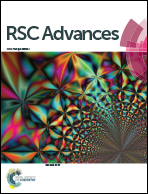A single colorimetric sensor for multiple target ions: the simultaneous detection of Fe2+ and Cu2+ in aqueous media†
Abstract
This study demonstrates the design, synthesis and sensing properties of a simple and efficient chemosensor 1 (1 = 2,6-bis((2-(((pyridine-2-yl)methylamino)methyl)phenol)ethylamido)pyridine) to rapidly detect Fe2+ and Cu2+ in aqueous solution (bis-tris buffer/DMF (8/2, v/v)), exploiting UV-vis spectral analysis, naked-eye and paper devices. The sensor 1 showed significant absorption spectra at 455 nm for Fe2+ and 660 nm for Cu2+, which are responsible for color changes due to the metal-to-ligand charge-transfer. The binding modes of 1 with Fe2+ or Cu2+ have been investigated by Job plot and ESI-mass analysis. In addition, the sensor 1 could be recyclable simply through treatment with a proper reagent such as EDTA. Moreover, the sensor has been used in the development of practically viable colorimetric kits.


 Please wait while we load your content...
Please wait while we load your content...